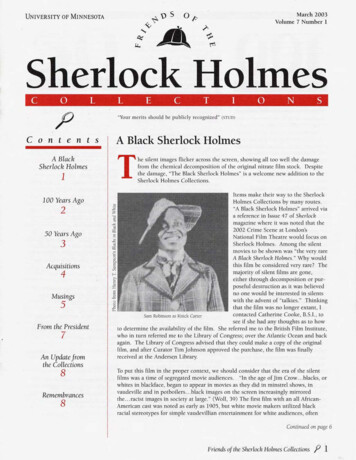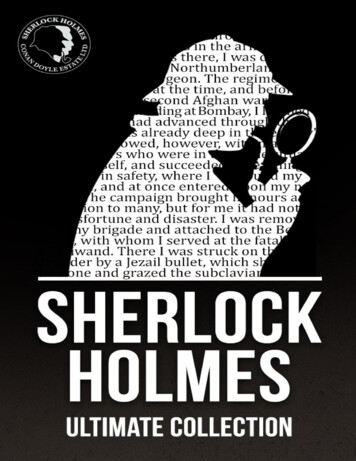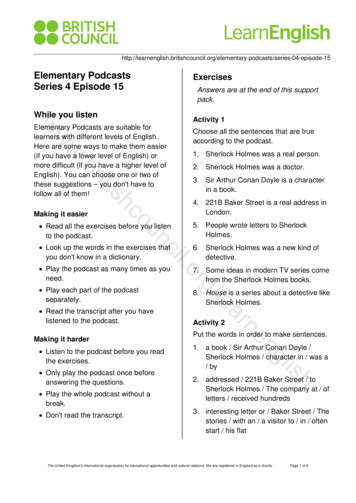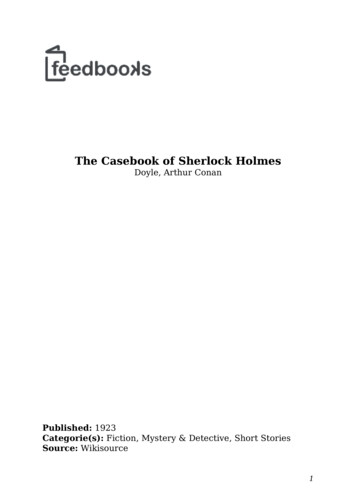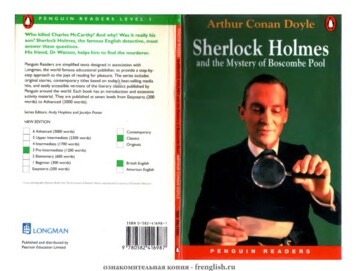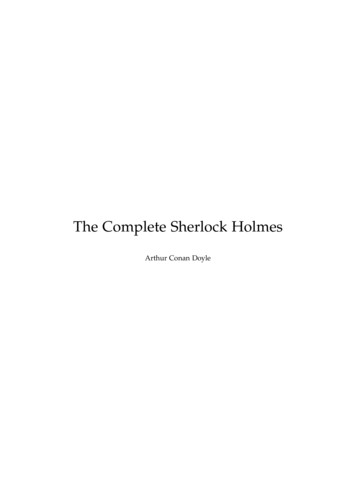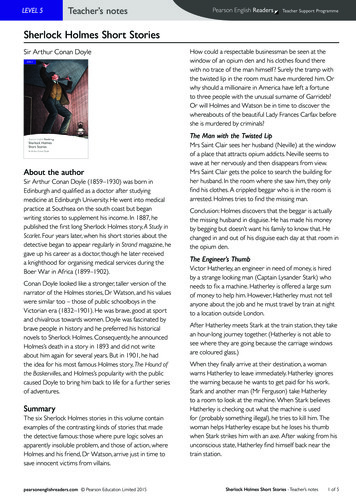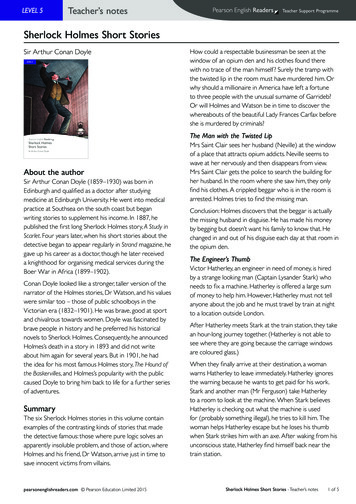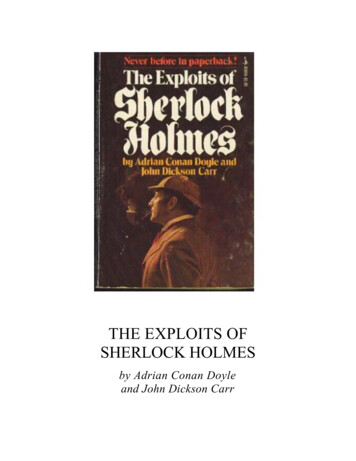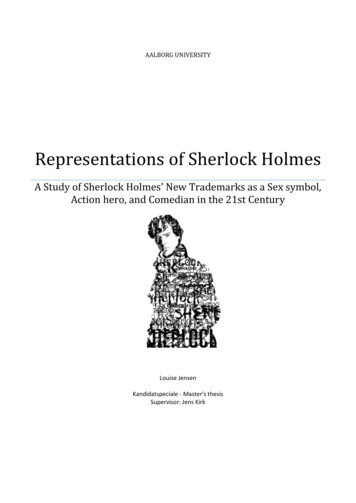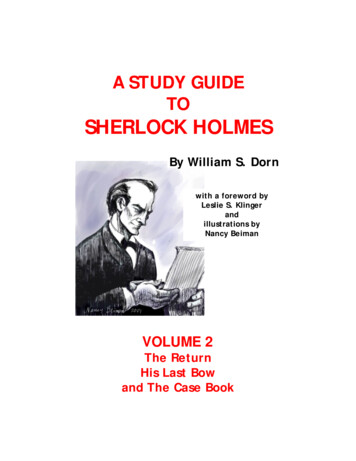
Transcription
A STUDY GUIDETOSHERLOCK HOLMESBy William S. Dornwith a foreword byLeslie S. Klingerandillustrations byNancy BeimanVOLUME 2The ReturnHis Last Bowand The Case Book
A Study Guide to Sherlock Holmes, Volume 1 and Volume 2by WILLIAM S. DORNThese two e-books are available free of charge to members of TheBeacon Society. Please visit the website for information on how toparticipate in our programs.www.BeaconSociety.comA Scion Society of The Baker Street IrregularsOther Sherlock Holmes e-books my be found at:www.BatteredBox.com
A STUDY GUIDETOSHERLOCKHOLMESVOLUME 2The Return,His Last Bow,andThe Case Booki
Copyright 2000, 2012 Pencil Productions Limited817 Detroit Street, Denver, Co. 80206No part of this publication may be reproduced, stored in a retrieval system, ortransmitted, in any form or by any means, electronic, mechanical, photocopying,recording or otherwise, without the prior written permission of the publisher.Library and Archives Canada Cataloguing in PublicationDorn, William S.A study guide to Sherlock Holmes, Volume 1, The novels, theadventures, and the memoirs / by William S. Dorn ; with aforeword by Julia Carlson Rosenblatt.Volume 2, The Return, His Last Bow and The Case Book witha Foreword byLeslie S. Klinger.Includes bibliographical references and index.Volume 1: ISBN 0-9619318-4-1 – e-book: ISBN-13: 978-1-55497-194-7Volume 2: ISBN 0-9619318-6-8 – e-book: ISBN-13: 978-1-55497-195-41. Doyle, Arthur Conan, Sir, 1859-1930—Characters—Sherlock Holmes.2. Detective and mystery stories, English—History and criticism. 3. Holmes,Sherlock (Fictitious character) 4. Detective and mystery stories, English—History and criticism I. Title.PR4624.D672000 823’.8QBI00-901065E-Books April 2012George A. Vanderburgh, PublisherTHE BATTERED SILICON DISPATCH BOXtme-Mail: gav@cablerocket.com * Website: www.batteredbox.comWeblog: www.batteredbox.wordpress.commagicJack: (519) 800-7076 or (608) 721-2166P. O. Box 50, R.R. #4Eugenia, OntarioCANADA N0C 1E0P. O. Box 122Sauk City, WisconsinU.S.A. 53583-0122
A STUDY GUIDETOSHERLOCK HOLMESVOLUME 2The Return,His Last Bow,andThe Case BookbyWilliam S. Dornwith a foreword byLeslie S. Klingeriii
“A huge rock, falling from above boomed past me, ”The Adventure of the Empty HouseArtist: Nancy Beimaniv
DEDICATIONThis volume is dedicated to the women in my life: Abigail,Claire, Dolores, Emily, Erica, Hannah, Julie, Pamela, and —most especially — Nancy. What more could a man ask forthan to be surrounded by nine beautiful, talented, and lovingwomen?William S. DornDenver, ColoradoSeptember 1, 2001v
ACKNOWLEDGEMENTSThe author wishes to thank the hundreds of students from theUniversity of Denver who suffered through the classes that arethe foundation for this book. Their interest and enthusiasmover the more than 25 years that these classes were held was aninspiration. The comments and criticisms of all of these students,and especially Violet Armour, Bev Bridges, David Von Drehle,Mary Mathiesen, and Mary McGivern, helped shaped thematerial presented here in many ways.The author also wishes to express his gratitude to two fellowSherlockians, Ron Lies and John Stephenson. Ron carefully readeach and every quiz – there are 180 of them in the twovolumes – and found numerous errors and oversights. I can onlyhope that I corrected most of them. John Stephenson made hisextensive library of Sherlockiana available for my use and wasmost gracious in his hospitality when I visited his library. Toboth of these distinguished scholars and good friends, there is noway I can adequately express my thanks.I also would be remiss if I did not acknowledge Dr. George A.Vanderburgh who first suggested this project and providedthe author with untold support in its creation. Without hisadvice and counsel the book certainly would never have seen thelight of day.Finally, the author must acknowledge the substantial contribution made by the illustrations of the distinguished Sherlockian artist,Nancy Beiman, whose talent and patience with a querulous authordefy description.vi
TABLE OF CONTENTSIntroduction .1The Return of Sherlock Holmes .7The Empty House .9The Norwood Builder .16The Dancing Men .25The Solitary Cyclist .34The Priory School .41Black Peter .50Charles Augustus Milverton .59The Six Napoleons .67The Three Students .77The Golden Pince-Nez .84The Missing Three-Quarter .92The Abbey Grange .100The Second Stain .109Answers to Quizzes.118His Last Bow . 121Wisteria Lodge .123The Cardboard Box .132The Red Circle .139The Bruce-Partington Plans .148The Dying Detective .154The Disappearance of Lady Frances Carfax .162The Devil’s Foot .171His Last Bow .178Answers to Quizzes.186vii
Table of ContentsThe Case Book of Sherlock Holmes . 188The Illustrious Client.190The Blanched Soldier .199The Mazarin Stone .207The Three Gables.214The Sussex Vampire.223The Three Garridebs .232The Problem of Thor Bridge .241The Creeping Man .250The Lion’s Mane .258The Veiled Lodger .266The Shoscombe Old Place .272The Retired Colourman .281Answers to Quizzes.288Bibliography . 290Index . 292viii
FOREWORDWhy teach a class about Sherlock Holmes? According to my wife,the reason was simple: It was a chance to talk about my favouritesubject for eighteen hours! (and, in true professorial manner, torequire that students buy one or more of my books!) In truth, Iwanted an opportunity to present Sherlock Holmes and hisworld in a fashion which would make students understand whythe subject has fascinated scholars for over 100 years. To do that,however, requires a curriculum, an organized approach to thesubject.Bill Dorn’s splendid pair of Study Guides provide the would-beinstructor (and the would-be student) with exactly that: an intelligent, rounded approach to the Canon. Bill’s books encouragethe student first, and most importantly, to read the stories. Thereis no room for fanciful biography in this guide – no “brickswithout straw” here. Instead, the student is urged, and tested, toread with careful attention to detail. But make no mistake: Thisis no book of trivia contests, designed to reward those with nearphotographic memories. Instead, the material allows theinstructor to push the student to give more and more attentionto the characters, major and minor, and the locales, which givethe Canon its life.Where the Guides depart most from the typical quiz books is inDorn’s knowledge and presentation of the scholarship surrounding the Canon. For me, the real fascination of the world ofSherlock Holmes has always been those oh-so-ponderablequestions: Where was Watson’s wound(s)? To whom was hemarried? What was that snake? Dorn presents in context many ofthe classic issues for serious study, adding his own pertinentquestions.ix
ForewordHow did Watson support himself after moving back to BakerStreet? (The Adventure of the Norwood Builder) Why didn’tGennaro Lucca simply write a letter to his wife? (The Adventureof the Red Circle) These “open questions” as Dorn characterizesthem, lead the student to read the Canon with a critical eye and,one hopes, to produce original scholarship.“As to your dates ,” the Guides help end the mystification byleading the student through the processes followed by theclassical chronologists. Dorn’s idea here is not to present anoverall chronology of the sixty tales but instead to instruct in themethodology of determining the date of each tale. This isaccomplished by assembling “clues” to the date and examiningthe conclusions suggested by them. Again, while the Guides leanheavily on classical chronological work, Dorn includes his ownideas and hopes to stimulate fresh analysis. And there is more:Dorn provides a story-by-story glossary, with “user-friendly”definitions of words which may be beyond the ken of youngerstudents (and those too young to have heard Victorian Englishspoken). These glossaries are organized by page numbers topermit the instructor to highlight the unusual words as theyappear, rather than require constant reference.In short, Bill Dorn has produced essential materials for anyserious instructor – or self-instructor for that matter – as well ascreating books that are a pleasure to look at and read for sheerenjoyment. I hope you find them as useful and enjoyable as I do!Leslie S. KlingerLos Angeles, CaliforniaSeptember 1, 2001x
IntroductionINTRODUCTIONThis study guide is intended for the beginning or intermediatescholar of the Sherlock Holmes stories of Sir Arthur ConanDoyle. It may be used for self-study or as notes for a formal class.This second volume is divided into three sections: TheReturn, His Last Bow, and The Case Book. A previous volumecovered The Novels, The Adventures, and The Memoirs.The entire text including illustrations is available on a CD-ROM.The CD-ROM is in PDF format and includes interactive table ofcontents and index. The file can be viewed and/or printed usingAdobe’s Acrobat Reader. That Reader can be downloaded freefrom http://www.adobe.com.The study guide for each adventure has four parts.1. An exercise in determining the date of the adventure.2. A vocabulary list, especially of Victorian terms, in the aventure.3. Some perplexing puzzles or open questions posed by theadventure.4. Three short, multiple-choice quizzes of varying degrees ofdifficulty.1. Exercises in Determining the DateThe reader is given specific clues regarding the date of theadventure and is asked to use Sherlock Holmes’s logic to find thedate most acceptable in light of the list of clues. The dates, asdetermined this way, will not lead to a chronology. The lattertask requires analyzing all 60 adventures as a body – a much toodifficult task for most scholars and certainly beyond thebeginning or intermediate scholar.1
Introduction2. VocabularyThe reader is given a list of words or phrases with pagereferences for each. Examples of the vocabulary words andphrases from “The Adventure of the Golden Pince-Nez” are palimpsestBath chairNihilists3. Open QuestionsMany of Sherlock Holmes’s adventures leave unansweredquestions. For example, from “The Adventure of the Red Circle”there is the questionOn page 907 Holmes says, “A single flash – that is A,surely. Now, then. How many did you make it? Twenty.So did I. That should mean T.” However, the Italianalphabet does not include K, so 20 flashes should be Unot T. How can you explain this discrepancy?and from “The Adventure of the Bruce Partington Plans” there isthe questionOn page 923 Sidney Johnson says, “I am always the lastman out.” Later on that same page he says, “I had nokeys of the doors – only the safe.” How can both ofthese statements be true?2
Introduction4. QuizzesAs noted earlier, there are three multiple-choice quizzes for eachadventure: a simple quiz, an intermediate quiz, and an advancedquiz.The simple quizzes are designed to test whether the adventurehas been read at all. Even novice Sherlockians will find thesimple quizzes easy. Indeed, anyone who has read a story — evencursorily — should get a perfect score on each quiz. A typicalsimple quiz question, this one taken from “The Problem of ThorBridge”, is:Neil Gibson’s wife was killed bya. a pistol shotb. poisonc. strangulationd. none of the aboveThe intermediate quizzes test whether that particular adventurehas been read with some degree of care. Serious students ofSherlock Holmes should have little difficulty with these quizzes.A typical intermediate quiz question, this one taken from “TheAdventure of the Norwood Builder” is:Who purchased Dr. Watson’s Kensington medicalpractice?a. Farquharb. Jacksonc. Vernerd. none of the aboveFinally, the advanced quizzes will challenge the most carefulreader and, indeed, may stump even long-standing Sherlockianscholars.3
IntroductionA typical advanced quiz question, taken from “The Adventure ofWisteria Lodge “ isWhere did Holmes and Watson find comfortablequarters in Esher?a.The Dingleb.High Gablec.The Bulld.none of the above5. More on the Finding of the DateThe exercises in finding the date are meant to be lessons inlogic – the logic of Sherlock Holmes – for beginning orintermediate scholars of the corpus of the 60 stores written by SirArthur Conan Doyle. The reader’s goal then should not be toarrive at a consistent chronology of the cases – a task that has lefteven such accomplished scholars as Baring-Gould, Bell, Brend,Christ, Dakin, and Zeisler in disagreement. After all, to constructa chronology requires tackling the entire 60 stories in the Canonsimultaneously. This is much too formidable a task for all but themost skilled scholar.The reader should simply try to arrive at the most acceptable dateconsistent with the clues given in these notes. All possible cluesfrom the story are not given in the notes. Rather the reader isgiven the fewest number of clues that lead to a reasonable date.Some examples of clues and where they lead are:4
IntroductionFrom “The Adventure of the Dying Detective”1. Watson says, “ she (Mrs. Hudson) came to myrooms in the second year of my marriedlife “ (932) 2. Watson was married in late 1888 or early 1889These two clues lead to the conclusion thatA. It was late 1890 or early 1891.Next3. Watson says that he went to visit Holmes andlooked at him, “In the dim light of a foggyNovember day “ (932)The conclusion from A and 3 isB. It was November 1890What is the purpose of these dating exercises if it is not to createa chronology? Each time the reader performs the logical stepsleading to a date for one of the adventures, he or she shouldbecome more skilled at finding solutions to real-life problemsand, in the process, learn to challenge unsubstantiated claimsmade by other people or groups. So have some fun andremember that these are exercises in the logic of SherlockHolmes – nothing more, nothing less.5
Introduction6
The ReturnofSherlock Holmes7
The Return“Absolute exhaustion – possibly mere hunger andfatigue,” said I, with my finger on the thready pulse The Adventure of the Priory SchoolArtist: Nancy Beiman8
Empty HouseTHE EMPTY HOUSEDATE OF THE ADVENTURE*(Date of the capture of Colonel Moran)CLUES:1. Watson says, “It was the spring of the year 1894 . “ (483)2. Ronald Adair was murdered on March 30, 1894 (484)3. On the night Col. Moran was captured, Watson says, “It wasa bleak and boisterous night . “ (490)4. The only bleak and boisterous night in early April of 1894was April 5.5. In 1894 the first day of April was on Sunday.CONCLUSIONS:A.B.C.D.1 implies it was spring of 18942 implies it was shortly after March 30, 18943 and 4 imply it was April 5, 1894C and 5 imply it was Thursday, April 5, 1894Colonel Moran was captured onThursday, April 5, 1894*The story may contain other clues to the date of the adventure. However, use onlythe clues shown here. Your only goal should be to use logical reasoning to find adate based on the clues shown here.9
The ReturnTHE EMPTY HOUSEVOCABULARY WORDSwhist (484) – card game, a predecessor to bridge, played by twoteams of two players, in which the last card dealtindicates trump; tricks of four cards are played,and a point is scored for each trick over six wonby each team.bibliophile (485) – lover of bookswizened (485) – withered, shriveledinexorable (486) – relentless, inflexiblebaritsu (486) – selected methods of ju-jitsuabyss (487) – deep gulf or chasmsardonic (488) – disdainful, sneering, bitterascetic (488) – one who practices self-denial or leads an austerelifegarroter (490) -- stranglerjew's harp (490) – small metal instrument consisting of a lyrelike shaped frame and metal tongue, pluckedwhile holding against the teeth; now called amouth harpasperity (490) – sharpness of tonesibilant (491) – hissingshikari (492) – sportsman or huntergibes (492) – mocking words, jeers10
Empty HouseTHE EMPTY HOUSEOPEN QUESTIONS1. Colonel Moran had seen Holmes at the Reichenbach Fallsand therefore knew that Holmes was still alive. Moran musthave told all of criminal London. Why then did Holmesvanish for three years?Perhaps Holmes thought that Moran would no longer haveany influence after Moriarty’s death or perhaps he was trying to discredit Moran among the rest of criminal London.2. What difference would it make if the public thought thatHolmes was dead?Perhaps no difference at all.3. Was the later Holmes an imposter?Many people think he was. After all, the ‘new’ Holmesnever used drugs as the earlier one did.4. On page 469 (The Final Problem) there is a reference toColonel James Moriarty. On page 494 (The Empty House)we see the name Professor James Moriarty. What was theProfessor's name? (HINT: See the name Norman Neruda onpages 34 and 36 of "A Study in Scarlet".)On a previous occasion,Watson forgot to hyphenate a lastname when he wrote Norman Neruda (34) which shouldhave been Norman-Neruda. The last name of the coloneland the professor was James Moriarty and should have beenhyphenated as James-Moriarty.11
The Return5. On page 487 Holmes says "There were at least three otherswhose desire for vengeance upon me would only be increasedby the death of their leader." However, at the time allHolmes knew was the news in the wire from the Londonpolice saying that "They have secured the whole gang with theexception of him (Moriarty)." (see page 476). Who then werethe three?Moran and two others.6. On page 487 Holmes says, "I might. have reversed myboots .". How would he do that? Have you ever tried to puton your shoes with the toes at the back?Perhaps Holmes did not mean ‘putting your feet inbackwards’ but merely walking backwards.12
Empty HouseTHE EMPTY HOUSESIMPLE QUIZ*1. At the beginning of the story Holmes was disguised asa.b.c.d.a Scotland Yard detectivea priesta bibliophilenone of the above2. Who moved the bust of Sherlock Holmes every quarter of anhour?a.b.c.d.Mycroft Holmesone of the Baker Street IrregularsMrs. Hudsonnone of the above3. What did Colonel Moran use to try to kill Holmes?a.b.c.d.*a brick thrown from a rooftopa horse drawn carriage careening down the streetan air-gunnone of the aboveThe Simple Quiz is designed to determine if the student has read the story. Anyonewho has read the story through should have no trouble in completing this quiz.The Intermediate and Advanced Quizzes are more challenging.13
The ReturnTHE EMPTY HOUSEINTERMEDIATE QUIZ#1. What type of wrestling did Holmes say he had “ someknowledge of “?a. baritsub. jujitsuc. hand-to-handd. none of the above2. Who was the one confidant that Holmes had during histhree year absence?a. Mrs. Hudsonb. Mycroftc. Lestraded. none of the above3. What name did Holmes use during his three year absence?a. Altamountb. Parkerc. Sigersond. none of the above4. Which one of these four places did Holmes NOT visit duringhis three year absence?a. Franceb. Khartoumc. Switzerlandd. Tibet#The Intermediate Quiz is designed to test whether the student has read the storywith reasonable attention to detail. The Simple Quiz is an easier test while the Advanced Quiz is much more challenging.14
Empty HouseTHE EMPTY HOUSEADVANCED QUIZ&1. To whom was the Honourable Ronald Adair engaged?a. Violet de Mervilleb. Grace Milnerc. Edith Woodleyd. none of the above2. Which one of the following was NOT playing whist withRonald Adair on the afternoon of his death?a. Lord Balmoralb. Sir John Hardyc. Colonel Morand. Mr. Murray3. Who made the air gun that Colonel Moran used to killRonald Adair?a. a blind German mechanicb. a French inventorc. an ex-British spyd. none of the above4. In what year was Colonel Moran born?a. 1820b. 1840c. 1860d. none of the above&The Advanced Quiz is designed for aficionados of the Canon. The questions arequite challenging. The Intermediate and Simple Quizzes are designed for the morecasual reader of the stories.15
The ReturnTHE NORWOOD BUILDERDATE OF THE ADVENTURE*(Date when Jonas Oldacre was flushedfrom his hiding place)CLUES:1. Watson says, “ Holmes had been back for somemonths, “ (496)2. Holmes returned in “The Adventure of the Empty House” inApril 1894.3. Holmes says, “I crawled about the lawn with an August sunon my back, “ (504)4. Holmes may not have meant literally an August sun; he maymerely have meant a hot summer sun.5. Holmes says, “ it had not rained for a month.” (504)6. The summer of 1894 was generally quite wet except for June11 to July 6 when there was practically no rainfall.7. On the day the case opened Holmes says, “The weather hasbeen very warm these last few days.” (497)8. From June 28 through July 2 of 1894 the temperature inEngland was above 80o every day.9. On the day the case opened Holmes was “ unfolding hismorning paper “ (496) which turned out to be the DailyTelegraph (497).10. The Daily Telegraph is not published on Sunday.11. July 1, 1894 was Sunday.12. Watson says, “ when I came down to breakfast (the nextmorning) An open telegram lay upon the table.” (505)13. Holmes responded to the telegram and went to Norwoodthat day where he flushed Oldacre from his hiding place.*The story may contain other clues to the date of the adventure. However, use onlythe clues shown here. Your only goal should be to use logical reasoning to find adate based on the clues shown here.16
Norwood BuilderCONCLUSIONS:A.B.C.D.E.1 and 2 imply it was 1894 after AprilA, 3 and 4 imply it was summer of 1894B, 5 and 6 imply it was early July of 1894C, 7 and 8 imply the case opened on July 1 or July 2 of 1894D, 9, 10, and 11 imply the case opened on Monday, July 2,1894F. E, 12 and 13 imply that Oldacre was discovered on Tuesday,July 3, 1894Jonas Oldacre was flushed from his hiding place onTuesday, July 3, 189417
The ReturnTHE NORWOOD BUILDERVOCABULARY WORDSdeprecation (496) – belittlingdemur (496) – hesitate because of doubts or scruplespalpitating (496) – trembling, shakingsolicitor (497) – attorney who is not a member of the bar andwho may be heard only in the lower courtsFreemason (497) – member of the Free and Accepted Masons,an international fraternal and charitableorganization with secret rites and signsindorsed papers (498) – papers with signatures on the back asevidence of the legal transfer of itsownershipconflagration (498) – large, destructive fireE. C. (498) – East Central postal district in London thatincludes The City and the financial districtFrench windows (498) – pair of windows extending to the floorand opening in the middlescrip (500, 505) – an interim document to be exchanged for amore formal certificate when payments havebeen made on stocks or bondsfrugal (500) – meagerpoints (501) – details or distinguishing featuresflurried (502) – confused or agitatedfrockcoat (502) – double-breasted coat with knee-length skirtsblackguard (503) – scoundrelaviary (503) – enclosure for holding birds in confinementvilla (503) – house in a middle-class suburbtreasure-trove (503) – hidden treasureprivet hedge (503) – hedge formed by green-leaved plant thathas clusters of white flowersfiasco (504) – complete failureclose as wax (504) – tight-lipped18
Norwood Buildertinder (504) – readily combustible material, such as dry twigs,used to start firesparoxysm (504) – sudden outburst of emotioninanition (505) – exhaustioninsolence (506) – being presumptuous and insulting in manneror speech; arrogantequanimity (507) – quality of being calm and even-temperedouthouse (507) – building separated from the main buildingconjurer (508) – someone who performs magic tricks;a magicianchaffed (508) – made fun of or teased in a good natured waywizened (508) – dried up; withered or shriveledodious (508) – offensive or disgustingfoolscap (509) – sheet of writing paper measuring approximately 13 by 16 inches with a watermark of afool's cap with bells19
The ReturnTHE NORWOOD BUILDEROPEN QUESTIONS1. Watson says, “ I had at his (Holmes’s) request sold mypractice and returned to share the old quarters in BakerStreet.” (496) Where did Watson get the money to supporthimself after moving back to Baker Street?Watson’s income could have consisted of (a) royalties fromhis published stories of Holmes’s adventures, (b) interest onthe investment of the money he received from the sale ofhis practice, and/or (c) a stipend from Holmes in exchangefor Watson’s assistance in succeeding cases.2. MacFarlane says, “The will was duly finished, signed, andwitnessed by my clerk.” (500) However, a will must have twowitnesses. Was Oldacre’s will illegal?If there were only one witness, then the will was illegal.Perhaps, however, the will was witnessed by a secondperson – a clerk in a neighboring office – and MacFarlanenever thought to mention that fact. It also is possible thatMacFarlane was not a very good lawyer.3. When Lestrade says, “You are aware that no two thumbmarks are alike?”; Holmes replied, “I have heard somethingof the kind.” (506) The subsequent activities show thatHolmes had heard and knew much more than he impliedwith his statement. Why then did Holmes reply to Lestradeas he did?Holmes probably was either (a) pulling Lestrade’s leg or (b)was intentionally vague to assure that Lestrade didn’t solvethe case before he (Holmes) solved it.20
Norwood Builder4. Holmes says, “Well, well, I daresay that a couple of rabbitswould account both for the blood and for the charredashes.” (510) Were the Scotland Yard detectives so incompetent that they could not see the difference between humanand rabbit bones? And why didn’t Holmes ask for an analysis of the bones as further evidence of his client’s innocence?The Scotland Yard detectives were either incompetent ornot thorough. Holmes, of course, didn’t come to theconclusion that the bones were rabbit bones until after hisclient had been cleared by the discovery of Jonas Oldacre.21
The ReturnTHE NORWOOD BUILDERSIMPLE QUIZ*1.Where was Jonas Oldacre hiding?a.b.c.d.2.What clue did Holmes immediately recognize as a fakeclue?a.b.c.d.3.a thumb printa forged signaturea torn photographnone of the aboveWhat was the connection between Jonas Oldacre andJohn Hector McFarlane’s mother?a.b.c.d.*in his lumber yardin the cellarin a hidden roomnone of the abovethey were brother and sisterOldacre had been a suitor of Mrs. McFarlaneMrs. McFarlane had been Oldacre’s housekeepernone of the aboveThe Simple Quiz is designed to determine if the student has read the story. Anyonewho has read the story through should have no trouble in completing this quiz.The Intermediate and Advanced Quizzes are more challenging.22
Norwood BuilderTHE NORWOOD BUILDERINTERMEDIATE QUIZ#1. What was Jonas Oldacre’s business?a.b.c.d.builderland speculatorlawyernone of the above2. What was the location of Graham and McFarlane, John Hector McFarlane’s place of business?a.b.c.d.the Gresham BuildingsKing Edward StreetLyon Placenone of the above3. Where did Jonas Oldacre write his will?a.b.c.d.in a hansomin a trainin McFarlane’s officenone of the above4. Who purchased Dr. Watson’s Kensington medical practice?a.b.c.d.#FarquharJacksonVernernone of the aboveThe Intermediate Quiz is designed to test whether the student has read the storywith reasonable attention to detail. The Simple Quiz is an easier test while the Advanced Quiz is much more challenging.23
The ReturnTHE NORWOOD BUILDERADVANCED QUIZ&1. Early in the story Watson mentions the Friesland. What wasthe Friesland?a. a Dutch steamshipb. a past case of Sherlock Holmesc. a city in Denmarkd. none of the above2. How old was Jonas Oldacre?a. 52b. 63c. 70d. none of the above3. Where did John Hector McFarlane spend the night aftervisiting Jonas Oldacre?a. the Anerly Armsb. the Crown Innc. the Northumberland Hoteld. none of the above4. What was the name of Jonas Oldacre’s housekeeper?a. Mrs. Dixonb. Mrs. Lexingtonc. Mrs. Warrend. none of the above&The Advanced Quiz is designed for aficionados of the Canon. The
A Study Guide to Sherlock Holmes, Volume 1 and Volume 2 by W ILLIAM S. D ORN These two e-books are available free of charge to members of The Beacon Society. Please visit the website for information on how to participate in our programs. www.BeaconSociety.com A Scion Society of The Baker Street Irregulars Other Sherlock Holmes e-books my be .
